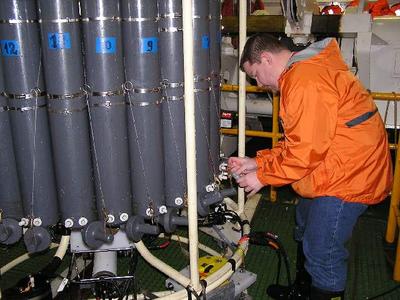
|
|
12 July, 2003
We're hitting the stations pretty hard now. After a short section in
the Bering Sea a couple of days ago, and a few stations along the
way, we have begun an intensive program of closely spaced stations
beginning at a point a few miles east of Point Barrow, Alaska. From
there we head in a northeasterly direction stopping every 3 miles or
so to lower the rosette and collect our samples. In practical terms,
this means that no sooner have we finished one station, the ship has
arrived at the next. I began my watch at noon on station 16, and by
midnight, we were doing station 24.
A station, by the way, is simply a location where we cast (drop) the
rosette. Our current location, for example, is 72 degrees, 5 minutes
north latitude and 154 degrees, 1 minute west longitude. A line of
stations is called a section. Each section has been planned by Jim
Swift, the Chief Scientist, and takes into account the nature of the
ocean bottom. Our highest priority work will consist of
approximately 4 closely-spaced shelf-basin sections and 3
similarly-spaced sections across the underwater Barrow Canyon. Of
course, ice conditions can modify the plan at anytime.
After station 26, the ship will take a "break" and come to a halt
while we wait for the lab folks to process the samples from the
rosette bottles; in other words, we can collect water samples faster
than we can measure them. The break should give many of us time to
catch up on things like reading, laundry, exercise, and sleeping.

Chief Scientist, Jim Swift, drawing a water sample that will be tested for its dissolved oxygen.

Graduate student, Jeremy Mathis, taking a nutrient sample from the rosette.
Contact the TEA in the field at
.
If you cannot connect through your browser, copy the
TEA's e-mail address in the "To:" line of
your favorite e-mail package.
|
